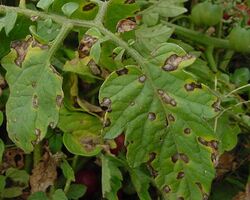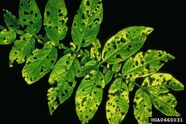| Septoria | |
|---|---|
| Septoria leaf spot | |
 |
|
| Septoria leaf spot on a Tomato leaf | |
| Scientific Classification | |
| Kingdom: | Fungi |
| Phylum: | Ascomycota |
| Class: | Dothideomycetes |
| Subclass: | Dothideomycetidae |
| Order: | Capnodiales |
| Family: | Mycosphaerellaceae |
| Genus: | Septoria |
| Species: | Septoria lycopersici |
 |
|
| Locations where septoria leaf spot is present (blue)[1] | |
| Synonyms | |
| Annular leafspot | |
Septoria leaf spot of tomato is caused by the fungus Septoria lycopersici. The fungus infects only solanaceous plants, of which tomato is the most important. Tomatoes may often be infected with leaf spot and early blight simultaneously, but the two diseases can be distinguished readily and the control measures are similar.[2]
Symptoms[]
Small, water-soaked circular spots 1.6-3.2mm (1/16-⅛in) in diameter first appear on the undersides of older leaves. The centers of the spots are gray or tan and spots have a dark brown margin. As the spots mature, they enlarge to about 6.4mm (¼in) in diameter and may coalesce. In the center of the spots are many dark brown, pimple-like structures. The structures are large enough to be seen with the unaided eye or with the aid of a hand lens. Pycinidia are absent from early blight lesions. Spots may also appear on stems, calyxes, and blossoms, but rarely on fruit. Heavily infected leaves will turn yellow, dry up, and drop off. This defoliation will result in sun scalding of the fruit.[2]
Treatment[]
Most fungicides registered for use on tomatoes would effectively control Septoria leaf spot. These include maneb, mancozeb, chlorothalonil, and benomyl. Captan is not effective and zineb may be difficult to purchase. Fungicides are normally applied on a 7-10 day schedule unless disease pressure is high. The first sprays are usually needed when early blight control begins (early to mid-July) unless infected transplants were used, in which case sprays are required during wet periods in June.[2]
Prevention[]
Make sure seed is acquired from disease-free seed-producing areas. Clear greenhouse of susceptible weeds and the previous season's tomato crop debris. Practice good sanitation. If infected plants are found, rogue the seedlings before transplanting. Practice at least a 1-year rotation of tomato. Make sure perennial weed hosts such as horsenettle are eliminated before planting. Resistance to Septoria leaf spot has been identified in several plant introduction lines. Currently no commercial varieties are resistant.[2]
Examples[]
References[]
- ↑ Data Sheets on Quarantine Pests - Septoria lycopersici var. malagutii. Prepared by CABI and EPPO for the EU under Contract 90/399003.
- ↑ a b c d Zitter, T.A. (1987). Septoria Leaf Spot of Tomato (Septoria lycopersici). Cornell University, Department of Plant Pathology. Ithaca, NY. Retrieved: 2010-07-30.

